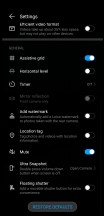Huawei Mate 40 Pro review

Camera hardware
The Mate 40 Pro comes with a set of three cameras on its back. Two of them come from the P40 Pro - the 'main' one and the telephoto, while the ultra wide-angle module is brand new.

This new ultra-wide now uses a 20MP sensor with a conventional Bayer RGB filter array instead of the 40MP Quad Bayer unit on the P40 Pro. You may remember that the P30 Pro had a 20MP ultra-wide, but this is not it - the Mate 40 Pro gets a new one.
Still, similarly to last year's Mate and the P40 Pro from 2020, the Mate 40 Pro's ultra-wide isn't all that ultra - it has an 18mm equivalent lens. Once again, its sensor has a native 3:2 ratio, like on a conventional camera, instead of the more squarish 4:3 units on most smartphones. The Mate's ultra-wide can autofocus too - Xiaomi and OnePlus do that, Samsung and Apple don't.
The primary camera is the 50MP one introduced on the P40 Pro. It packs a large 1/1.28" sensor with an RYYB Quad Bayer type color filter with 1.22µm individual pixel size - or 2.44µm for a 4-in-1 binned pixel. The lens in front has an f/1.9 aperture and a 23mm equivalent focal length, though, for one reason or another, the default 12MP pictures come out with a small crop to 27mm. There is no OIS here.
The telephoto is lifted off of the P40 Pro as well. It uses a stabilized periscope lens that delivers a focal length of 125mm or 135mm depending on who you ask, effectively meaning 5x zoom. The f/3.4 aperture may sound quite dim compared to the Note20 Ultra's f/3.0 tele, but we'll see how they stack up in the real world in a bit. There's a 12MP sensor behind the glass.
On the front, there are changes from the P40 Pro's setup - a 13MP fixed focus ultra-wide cam replaces the 32MP Quad Bayer unit that had autofocus. Sounds like a downgrade on paper, though the 18mm focal length comes with advantages of its own, as we'll see later on.
Camera interface
The camera app on the Mate 40 Pro is the same as on the P40 bunch, and it offers pretty much identical functionality to every other camera app out there. Our main beef with this one is the zoom selector. While it's reasonably accessible when holding the phone in portrait with the right hand, getting at it when using the Mate with the left hand or in landscape in either direction invariably requires another hand (or a nose, depending on the situation). With the zoom capability's ever-growing importance, the selector needs to be improved asap.

There's a Pro mode too where you can adjust parameters yourself - ISO (50 to 409,600), shutter speed (1/4000s to 30s), exposure compensation (-4 to +4EV in 1/3 stop increments), and white balance (presets and specific light temperature). You can also choose the metering mode (matrix, center-weighted, and spot) and the focus mode (single, continuous, and manual). If the phone thinks you messed up the exposure, an icon will pop up to warn you. Mind you, Pro mode is available on all three cameras, which isn't usually the case with competing phones. There's no Pro mode for video, which is a bit weird since the P40 Pro had one.
Huawei's approach to faux bokeh has been two-fold for years - there's both a Portrait mode and an Aperture mode. In Aperture, you can choose the simulated aperture in the range from f/0.95 to f/16. Post shot, you can change the aperture and the desired focus point within the Gallery.
In Portrait mode, you can enable and disable the background blur, but you can also choose the bokeh shapes - circles, hearts, swirl, or discs. You can also opt for simulated lighting, and you can add some beautification on a scale from 0 to 10.
Reader comments
- Niky Tamayo
- 18 May 2024
- DxW
Indeed. Still getting EMUI updates up till now. Security update last week, after a massive jump to EMUI 13 a few months back that added a whole bunch of connectivity features!
- Anonymous
- 21 Feb 2024
- vaS
While you lose on security updates, Google still updates anything related to them. Just like the HMS updates that Huawei does to anything they made past the sanctions. These people are just looking for excuses to buy a new phone.
- Anonymous
- 21 Feb 2024
- vaS
Too bad you didn't see Aurora Store.





